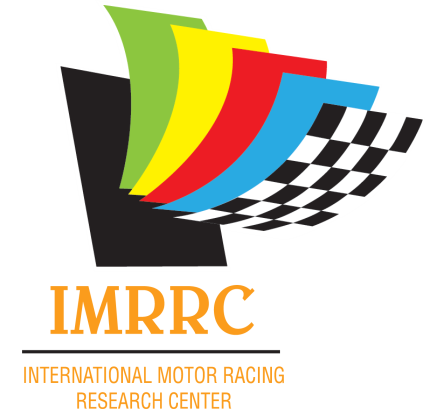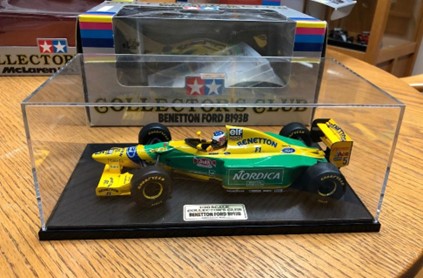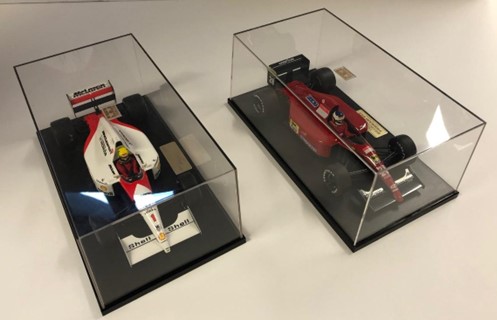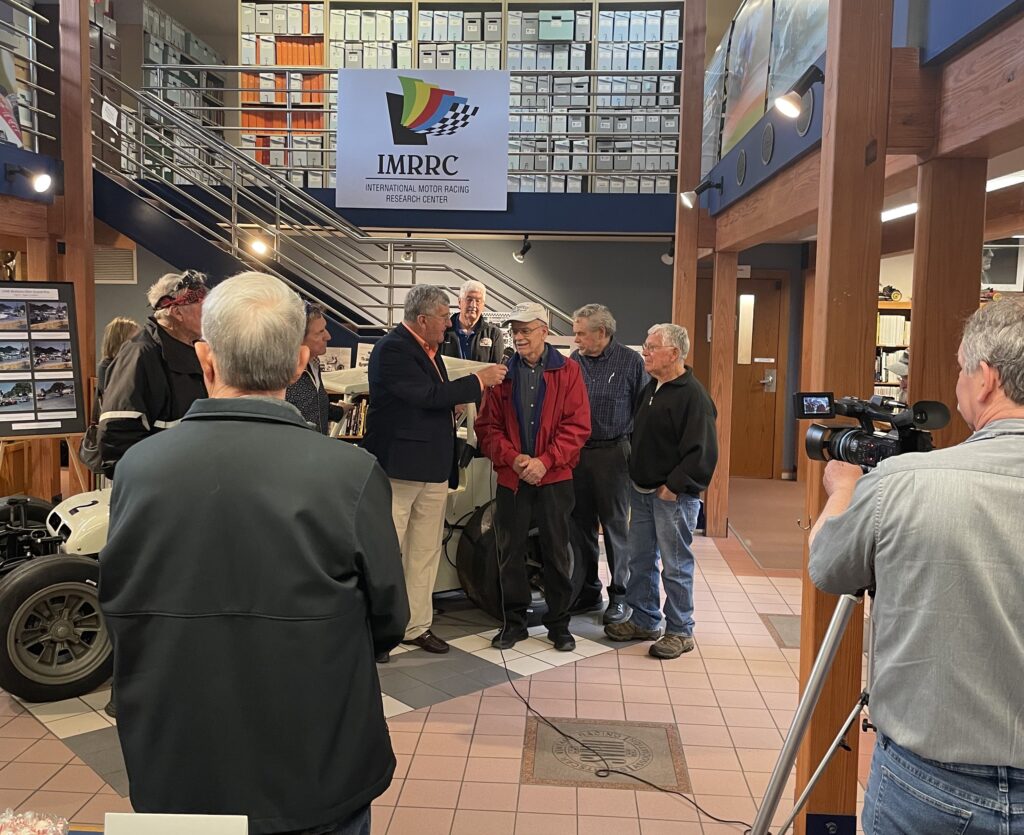Two-Day Event Provides Insights into the History of Motorsports

Presenter Quinn Beekwilder discusses the current state of motorsport research with Symposium cofounder Don Capps.
The Eighth Annual Michael R. Argetsinger Symposium on International Motor Racing History was held on November 1 and 2 at the Media Center at Watkins Glen International. Hosted jointly by the International Motor Racing Research Center and the Society of Automotive Historians, with support from WGI and the Watkins Glen Area Chamber of Commerce, the Symposium provides a forum for motor racing scholars, journalists and writers of motor racing history to present their research findings and share projects with each other and racing enthusiasts, both in person and through live-streaming of the event. Topics are wide-ranging, and the well attended, two-day event included topics such as “Perspectives on Motorsport Journalism, 1952-1972,” presented by faculty from McPherson College; “The Best Year of Our Lives – the Rebirth of Postwar European Motorsports,” presented by Professor Elton G. McGoun of Bucknell University; and “Studebaker at Indianapolis,” presented by Andrew Beckman, Archivist at the Studebaker National Museum. In all, experts and avid enthusiasts of motor racing history gave 19 additional talks.
8th Annual – 2024 Live-Stream Presentations
From Powder Puff to W Series: The Evolution of Women-Only Racing
to women. Consequently, it has been necessary for female racers to develop unique strategies to enter what has long existed as an exclusive ...masculine enclave. While entry can be facilitated through a familial relationship with a male driver, women without such connections often get their start through participation in women-only racing events. Although these races have provided women with the opportunity to enter the track, they have not been without controversy. Detractors argue that women will not be considered legitimate racers unless they compete on the same track as men. Proponents view women-only racing not only as a way to attract more women into the sport, but also as an important source of skill development, support, and community building.
This paper investigates the evolution of women-only racing, from its early introduction as a media stunt, to its current incarnation as a proving ground for serious female open-wheel racers. Informed by archival resources and motorsport scholarship, it considers how women-only racing complicates, facilitates, and liberates women’s entry, participation, and recognition in the masculine world of motorsports.
This livestream was presented via twitch.tv/grantouringmotorsports and produced by The Motoring Podcast Network - learn more at https://www.motoringpodcast.netShow More










FULL LENGTH RECORDINGS: DAY 1, DAY 2
Over the years, the IMRRC has “come to the rescue” of devoted authors who are committed to publishing in-depth, definitive works. Such services might include the discovery of photographs, fact checking, or filling in the gaps within a particular marque history or driver’s career.
Such is the case with author Alejo Pérez Monsalvo. Recently, we were pleasantly surprised when we received a weighty, overseas package from Alejo. In the box was a complimentary copy of his exhaustive tome documenting the De Tomaso road and racing cars, completed through the diligence of the IMRRC’s research services team. Alejo was exceedingly grateful for the IMRRC’s support; we were pleased to share our resources for the betterment of enthusiasts everywhere.
In anticipation of the upcoming holiday season, the IMRRC has lowered prices on many items in our online gift shop. Sales of duplicate books, expertly handled by IMRRC star volunteer Michael Hartney, can be found here. Memberships also make great gifts!
Summer is a busy time here at the IMRRC, with larger groups as well as families and individuals discovering our archive as a destination.
Tim Suddard, President of Grassroots Motorsports/Classic Motorsports magazines, led a group of 33 cars on a Finger Lakes-themed rally and thoughtfully included the IMMRC on his itinerary. Most of the visitors were new to the area and the IMRRC, and were eager to learn more about the 75 years of racing history at Watkins Glen, as well as our own history as a leading motorsport archive.
 |
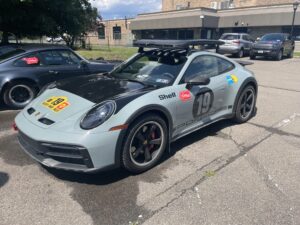 |
In late June, the Center hosted a group of Rolls-Royce Silver Ghost owners, led by long-time friend and supporter Tom Colbert. Astonishingly, these cars were driven exclusively – not trailered – with at least one example exhibiting the patina of decades of enjoyment on the open road.
 |
 |
Hidden within the volumes of paper documentation at the IMRRC you occasionally stumble upon “finds” of another nature. This can turn serious research into fun and games. One such discovery is the Auto Race Spe-Dem board game, produced under the “All-Fair Toys and Games” brand by Alderman, Fairchild Co. of Rochester, NY. The All-Fair brand was established in 1922, and Auto Race Spe-Dem was one of, if not the first of, their creations. Patent 1,413,481 was granted to Louis La Borie of Rochester, NY on April 18, 1922.
The board has a six lane track colored Blue (Buick), Yellow (Ford), Green (Paige), Red (Maxwell), White (Dodge), and Black (Saxon) with 16 spaces from start to finish and graphics printed on the “infield” of the track. The seventh space has a blowout hazard that causes any car landing on it to lose the next throw and not advance no matter what is rolled. The twelfth space has an accident hazard that sends the car back to the start line. There are six cubes and each of the six faces has the first letter of a car manufacturer. All six cubes are rolled each turn and the cars advance one space for each of the cubes showing its letter, first car to the finish line wins. The board has Auto printed in the upper left corner, Race in the upper right corner, and has the manufacturer’s name and patent information printed on it. The board is approximately 17” x 17.5” when open. There are six cast race cars, one of each color with the respective manufacturers name cast on the top of the rear curved portion of the body. Cars are approximately 1.75” long by 0.5” wide by 0.625” tall.
Over the years the board was modified slightly. One of those modifications replaced the Saxon with a Stutz. Initially one might think this was done to ensure current model vehicles were represented, as Saxon ceased manufacturing in 1924. But, this theory does not explain why Maxwell remained on the board well after it ceased production in 1925.
Spe-Dem was very popular, the 1928 All Fair catalog states that Spe-Dem Auto Race No. 355, “…is still our best seller.” The 1930, 1931, and 1932 catalogs also state that Spe-Dem “…is still one of our best sellers.”
Based on this popularity, a Junior Auto Race version was created for those as young as 3 years of age. The track was reduced to four lanes and a spinner was placed in the “infield” replacing the cubes in original game. It is unclear when the Junior version was introduced but it did appear in the 1928, 1930, 1931, and 1932 All-Fair catalogs.
Time to set aside the laptop, gather up five fellow racers and roll’em.
Like many research archives, the IMRRC collects selectively, not comprehensively. We don’t have the staff and space required to collect, process, and store EVERYTHING racing-related: the endless t-shirts and caps alone would overwhelm us! So, we focus on collecting items of greatest research value: books, periodicals, programs, archives of racing organizations and teams, personal papers, and photographs. But, we still want to build representative collections of other types of racing materials. Diecast and plastic models fall into the “representative” category, and while we don’t collect them comprehensively, they feature prominently at the Center. In fact, current diecast displays include a historical overview of Formula 1 cars, a selection of Richard Petty cars, and a case of McLaren F1 cars promoting our upcoming gala in honor of Zak Brown, who is receiving the 2024 Cameron R. Argetsinger Award.
To many, Tamiya is synonymous with modeling excellence. Tamiya is well-known for its finely-detailed models of aircrafts, cars, ships, and armor, as well as radio-controlled and diecast cars. Many of us have experienced the fun/frustration of assembling and painting a Tamiya model. Recently, thanks to a generous donation from Barbara Carson, widow of the late Robert D. Carson, of 98 model Formula One cars ranging from a 1936 Auto-Union to a 2004 Ferrari piloted by Michael Schumacher, we were excited to add several new Tamiya models to our collection.
The majority of the Tamiya diecast cars are from the company’s “Collector’s Club” collection. From an historical perspective, the highlights are 1:20 models of the Lotus 102B, which raced in 1991, and the Lotus 107B, which raced in 1992. Aside from being beautiful replicas of the cars, they are interesting because Tamiya sponsored Lotus from 1991-1993. Tamiya’s logo is prominently displayed on both cars’ wings – an accurate representation of the cars’ livery in those years.
Other 1:20 Collectors Club models in the donation include models featuring prominent drivers Michael Schumacher, Ayrton Senna, and Jean Alesi. All the models came complete in their original packaging and display cases.
Another interesting diecast car included in the gift is this 1/12 model of the Honda F-1 RA272. Designed by Yoshio Nakamura and Shoichi Sano, this car raced during the 1965 Formula One season, driven by Richie Ginther. The RA272 was the first Japanese car to win in Formula One, a fact proudly noted on the front of the box, “1965 Mexico G.P. Winning Machine.”
Finally, thanks to the generosity of Mike Fuller, we have two unassembled plastic model kits, both from Tamiya’s 1:12 “Big Scale Series” and sealed in their original boxes. The first is a model of the Williams FW14B Renault, designed by Adrian Newey and raced by Nigel Mansell and Riccardo Patrese during the 1991 and 1992 Formula 1 seasons.
The second is a Wolf WR1 Ford F1 built for the 1977 racing season and driven by Jody Scheckter and Keke Rosberg.
As noted, the IMRRC does not collect models comprehensively: we could easily fill our facility with models alone. But, models are nonetheless essential to our holdings. Models illustrate, in an accessible way, the development of race cars over time; they are wonderful examples of racing merchandising; they show one aspect of race fans’ devotion to the sport – their desire to build/collect replicas of favorite cars. The Tamiya models specifically are evidence of Tamiya’s close relationship with F1 and Lotus. Model cars are excellent educational tools. They are also colorful, and look incredible when displayed, and we feel they enhance our exhibits and collections.
The crowd — one of the largest to ever attend a Center Conversation — began arriving early for the opportunity to see the legendary Purdy Deuce supermodified “up close and personal”. The Deuce will next head off to driver Bentley Warren’s “Bentley’s Saloon” in Arundel, Maine for display for the balance of the year. Photographers Chris Burgess and Don Edds had tables with photographs of competition at Oswego Speedway and artist Jim Walker brought some of his artwork for display as well. Master model builder, Tom Clark brought his partially finished 1:18 scale model of the Deuce as well as the iconic rear engine Jim Shampine supermodified for display.
The Steel Palace, Oswego Speedway (FULL LENGTH)





Our morning session took place in the Center, around the car, and was moderated by Roy Sova. The gentlemen who were instrumental in the car’s restoration Steve Miller, Doug Holmes, and Lee Osborne talked about restoring a car that had sat dormant for 40+ years. The only 2 drivers still living who drove the car, Bentley Warren and Warren Coniam, gave their thoughts on Howard Purdy and what made the Deuce such a unique car to drive
Roy also did a short segment with Bob and Nancy Hodgson and Mrs. Purdy in the auditorium before the start of the main program, getting their memories of working on and racing the car.
The “main show” began at 1p.m. with a 13-minute video showing the history of the track. After the video, Dick O’Brien who was the PR person as well as manager at the Speedway for 40+ years spoke to the early history of the track and perhaps the single most important decision that was made in the early 1950’s, the decision to have supermodifieds as the only class of car racing at the track. He also told a great story of Mario Andretti racing at the track, but only after he first received the $1000.00 he had been promised for “transportation expenses.”
 After Dick’s presentation, the drivers were on stage. Bentley Warren, Warren Coniam, Eddie and Brandon Bellinger, Alison Sload (the only woman to win a supermodified feature), Otto Sitterly, Dave Danzer, and car owner/promoter John Nicotra spent the next 90 minutes answering a wide variety of questions posed to them by Roy Sova. The questions were great; eliciting responses that were funny, insightful, and gave the audience a bit of insight into each person AS a person.
After Dick’s presentation, the drivers were on stage. Bentley Warren, Warren Coniam, Eddie and Brandon Bellinger, Alison Sload (the only woman to win a supermodified feature), Otto Sitterly, Dave Danzer, and car owner/promoter John Nicotra spent the next 90 minutes answering a wide variety of questions posed to them by Roy Sova. The questions were great; eliciting responses that were funny, insightful, and gave the audience a bit of insight into each person AS a person.
Two supermodfieds were on display courtesy of Craig Danzer and Perry Adams. The Danzer car won the International Classic last year and Perry’s car was a Steve Miller machine from the 1970s, proving a fitting retrospective look at the evolution of the cars throughout the decades.
The next Center Conversation, “The Greatest Corvette Story Ever Told”, will be held on June 22nd at 6:00PM featuring The Camoradi #4 Corvette and its participation in the 1960 24 Hours of Le Mans, moderated by Richard Prince, Dominic Testa, and Chuck Schroedel.
Thanks to donations from Center friends we able to continually add duplicate books to our Race Shop online and at the Center. These are some of the books added in August that are now available: Klemantaski & Ferrari by Louis Klemantaski; Grand Prix! Rare Images of the First 100 Years by Quentin Spurring; The Insolent Chariots by John Keats; Sunday Driver by Brock Yates; Car Driving as an Art, A Guide for Learners and Advanced Drivers by S. C. H. Davis; The Immortal 2.9 Alfa Romeo 8C2900 (Revised Edition) by Simon Moore; Lotus, All the Cars by Anthony Pritchard; Montezuma’s Ferrari … and other adventures! by BS Levy; GT 40: An Individual History and Race Record by Ronnie Spain; GT40 Photo Archive, edited by Brian Winer and Wallace A. Wyss; The Story of Lotus, 1947-1960, Birth of A Legend by Ian H. Smith; Ferrari, Great Marques by Godfrey Eaton; Northeast American Sports Car Races, 1950-1959 by Terry O’Neil; GT40, An Individual History and Race Record by Ronnie Spain; Ford GT40: Production and Racing History, Individual Chassis Records by Trevor Legate; Twice Lucky, My life in motorsport by Stuart Turner; The Cars in My Life by W.O. Bentley; The Birth of Chrysler Corporation and Its Engineering Legacy by Carl Breer; Modena Racing Memories, Italian Sports Car & Grand Prix Racing 1957-1963 by Graham Gauld; Pro Sports Car Racing in America 1958-1974 by Dave Friedman.
Little League World Champions Maine-Endwell gathered at the Racing Research Center’s raffle Mazda MX-5 Miata over the Labor Day weekend at Watkins Glen International. The boys, from Maine-Endwell, N.Y., not too far from Watkins Glen, served as grand marshals for the IndyCar Grand Prix at the Glen on Sunday. Research Center staffers and volunteers were impressed with these talented and friendly world champions.
History is racing in Watkins Glen this week! Corvette, tied to Watkins Glen since its inception, will be the featured marque at the 23rd anniversary Grand Prix Festival of Watkins Glen on the village streets on Friday, Sept. 9. Friday also is the first day of racing for more than 400 cars are entered in SVRA’s U.S. Vintage Grand Prix presented by Jaguar at Watkins Glen International. For all of the details about the Grand Prix Festival, go to www.grandprixfestival.com. For details about the SVRA competition, go to www.theglen.com. The Racing Research Center will have a table at the downtown festival on Friday and at WGI on Saturday and Sunday. Additionally, the Center will be open late on Friday – until 9 p.m. Lots of opportunities to say hello to the staff and learn more about what’s going on at the Center. Hope to see you! (In the photo, Addison Austin races a Corvette in the 1955 Glen Classic Trophy race during the Watkins Glen Grand Prix weekend. This was the first Corvette to compete at The Glen. The photo is from the Center’s Gus Iacozili Collection)
